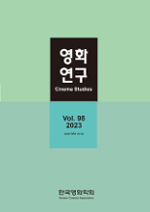- 영문명
- Cinematic and Historical Significance of Amgwang (Shin-ui Jang, 1925)
- 발행기관
- 한국영화학회
- 저자명
- 미즈노 나오키 정종화
- 간행물 정보
- 『영화연구』제83호, 5~41쪽, 전체 37쪽
- 주제분류
- 예술체육 > 예술일반
- 파일형태
- 발행일자
- 2020.03.31
7,240원
구매일시로부터 72시간 이내에 다운로드 가능합니다.
이 학술논문 정보는 (주)교보문고와 각 발행기관 사이에 저작물 이용 계약이 체결된 것으로, 교보문고를 통해 제공되고 있습니다.

국문 초록
부산의 조선키네마주식회사가 1925년 제작한 <암광=신의 장>은 식민지기 조선영화사에 큰 의미가 있는 영화이다. 조선키네마는 일본인이 설립하여 경영하던회사로, 이 영화의 각본ㆍ감독은 일본인 다카사 간초(高佐貫長: 조선명 왕필렬) 가 담당했으나 배우는 전원 조선인이었고 연출에는 윤백남도 관여했다. 이러한의미에서 <암광=신의 장>은 ‘일조(日朝)합작영화’ 라고 할 수 있다. <암광=신의 장>은 조선 사회에서 차별받던 백정(도부: 屠夫)을 주인공으로 한영화이자, 백정 차별이라는 사회 문제를 다룬 ‘현대극’이기도 했다. 1923년 백정출신들의 인권 확립과 해방을 촉구하며 조선형평사(朝鮮衡平社)가 창립되었으나, 형평운동(衡平運動)에 대한 일반 사회의 반발이 적지 않았고 형평사원과 일반 민중들 사이의 충돌 사건도 잦았다. <암광=신의 장>은 이러한 시대를 배경으로 제작된, 현대 사회의 모순을 문제 삼은 영화였다. 영화 <암광=신의 장>은 경찰의 검열을 받아 타이틀을 <암광>에서 <신의 장(粧)>으로 수정해야만 했다. <신의 장>이라는 타이틀은, 도부들 사이에서 가축을잡는 데 사용하는 칼을 가리키던 용어 ‘신(神)의 장(杖, 지팡이)’에서 유래했다고생각할 수 있다. 영화는 개제(改題)되어 경성에서 일단 개봉되었으나 ‘계급 투쟁’ 을 유발할 우려가 있다고 간주되어 상영이 금지된다. 그러나 이후 경상남도와 북도에서는 (연극)극장에서 상영되었고 순회 상영도 이루어진 것으로 보인다. 이는, 1926년 7월 ‘활동사진필름검열규칙’이 제정되고 조선 전체를 아우르는 영화검열체제가 정비되기 이전의 영화검열 상황을 드러내는 사례이기도 하다. <암광=신의 장>은 현대적인 문제를 다뤘음에도 불구하고, ‘치정-활극’으로 흘러 조선인의 감정에도 부합하지 못한 작품이 되어 버렸다는 식의 혹평밖에는 받지 못했다. 그러나 윤백남, 나운규, 주인규 등 조선영화사에서 중요한 역할을 담당했던 영화인들이 관여한 현대극이라는 점에서 그 영화사적 의미를 찾을 수 있다.
영문 초록
The 1925 film, Amgwang, produced by the Joseon Kinema Corporation in Busan, is a significant film in colonial Korean film history. The Joseon Kinema Corporation was founded and run by Japanese residents in Busan, and the screenplay and director of the film was also a Japanese, Kancho Takasa (高佐貫 長, his Korean name is Wang Pil-ryeol). All of the actors in the film, however, were colonial Koreans, and Yoon Baek-nam was involved in the directing. In this sense, Amgwang is a Japanese-Joseon co-production film. Dealing with a social problem of discrimination against butchers in Korean society, Amgwang i s a modern drama about a discriminated butcher named baekchong. Although the organization Joseon Hyeongpyeongsa was established calling for the liberation and human rights of baekchong in 1923, the public resistance to the Hyeongpyeong (meaning equity) Movement was not small, and there were frequent conflicts between Hyeongpyeongsa members and the public. Set in this era, Amgwang wa s the film that problematized the contradictions in Korean modern society. After the film was censored by the police, the title had to be modified from Amgwang to Shin-ui Jang. The title Shin-ui Jang can be thought to have originated from the term Shin-ui jang (meaning god’s cane) which refers to the knives used to slaughter livestock by butchers. The film was released and screened in Gyeongseong (Seoul) for a while, but before long, the authorities banned its screening for the reason that the film might cause a class struggle. However, it was shown at stage theaters in Gyeongsangnam-do and Gyeongsangbuk-do provinces since then, and appears to have been shown on a tour. This is an example of the film censorship before the Motion Picture Film Censorship Regulations was enacted in July 1926 when the censorship system covering the entire colonial Korea was reorganized. Despite dealing with the modern issue, Amgwang was criticized only for being an action film with a crime of passion which did not fit the Korean people’s sentiments. Nevertheless, the cinematic and historical meaning of the film can be found in that it is the modern drama involving filmmakers who played important roles in colonial Korean film history, including Yoon Baek-nam, Na Woon-gyu and Joo In-gyu.
목차
1. 들어가며
2. 조선키네마주식회사와 그 관계자
3. <암광>과 형평운동
4. 검열과 타이틀 변경 문제
5. <신의 장>에 대한 평가
6. 나오며
키워드
해당간행물 수록 논문
참고문헌
관련논문
예술체육 > 예술일반분야 BEST
- 빅데이터를 활용한 워케이션 트렌드 분석
- 생성형 AI 도구와 디자이너의 협업 프로세스 개발 - 이미지를 통한 아이디어 확산에서 고해상도 렌더링까지
- 포스트 코로나, 일상적 여가의 재발견
예술체육 > 예술일반분야 NEW
- 영화는 경찰 부패를 어떻게 재현하는가: 정당화와 침묵의 서사 분석
- 알모도바르의 영화 <룸넥스트도어 The Room Next Door>를 통해 본 죽음의 사회적 드라마
- 안성기의 스타 페르소나 연구: 1980년대 영화를 중심으로
최근 이용한 논문
교보eBook 첫 방문을 환영 합니다!

신규가입 혜택 지급이 완료 되었습니다.
바로 사용 가능한 교보e캐시 1,000원 (유효기간 7일)
지금 바로 교보eBook의 다양한 콘텐츠를 이용해 보세요!




